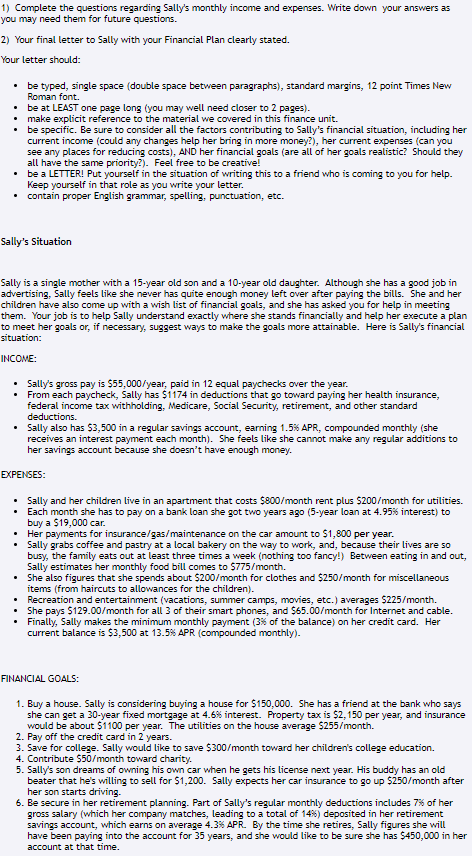Question
Question 2: What is Sally's monthly interest and dividend income? Question 3: What is Sally's total monthly income? Question 4: What is Sally's monthly expenses

Question 2:
What is Sally's monthly interest and dividend income?
Question 3:
What is Sally's total monthly income?
Question 4:
What is Sally's monthly expenses for rent/mortgage?
Question 5:
What is Sally's monthly utilities?
Question 6:
What is Sally's monthly expenses for her car including payment, gas and maintenance?
Question7:
What is Sally's monthly expenses for her credit cards?
Question 8:
What is Sally's monthly expenses for phone/internet/ cable?
Question 9:
What is Sally's monthly expenses for food?
Question 10:
What is Sally's monthly expense for clothing?
Question 11:
What is Sally's monthly expense for entertainment, gifts and miscellaneous expenses?
Question 12:
What is Sally's total monthly expenses?
Question 13:
What is the difference between Sally's expenses and her income?
1) Complete the questions regarding Sally's monthly income and expenses. Write down your answers as you may need them for future questions. 2) Your final letter to Sally with your Financial Plan clearly stated. Your letter should: be typed, single space (double space between paragraphs), standard margins, 12 point Times New Roman font. be at LEAST one page long (you may well need closer to 2 pages). make explicit reference to the material we covered in this finance unit. be specific. Be sure to consider all the factors contributing to Sally's financial situation, including her current income (could any changes help her bring in more money?), her current expenses (can you see any places for reducing costs), AND her financial goals (are all of her goals realistic? Should they all have the same priority?). Feel free to be creative! be a LETTER! Put yourself in the situation of writing this to a friend who is coming to you for help. Keep yourself in that role as you write your letter. contain proper English grammar, spelling, punctuation, etc. Sally's Situation Sally is a single mother with a 15-year old son and a 10-year old daughter. Although she has a good job in advertising, Sally feels like she never has quite enough money left over after paying the bills. She and her children have also come up with a wish list of financial goals, and she has asked you for help in meeting them. Your job is to help Sally understand exactly where she stands financially and help her execute a plan to meet her goals or, if necessary, suggest ways to make the goals more attainable. Here is Sally's financial situation: INCOME: Sally's gross pay is $55,000/year, paid in 12 equal paychecks over the year. From each paycheck, Sally has $1174 in deductions that go toward paying her health insurance, federal income tax withholding, Medicare, Social Security, retirement, and other standard deductions. Sally also has $3,500 in a regular savings account, earning 1.5% APR, compounded monthly (she receives an interest payment each month). She feels like she cannot make any regular additions to her savings account because she doesn't have enough money. EXPENSES: Sally and her children live in an apartment that costs $800/month rent plus 5200/month for utilities. Each month she has to pay on a bank loan she got two years ago (5-year loan at 4.95% interest) to buy a $19,000 car. Her payments for insurance/gas/maintenance on the car amount to $1,800 per year. Sally grabs coffee and pastry at a local bakery on the way to work, and, because their lives are so busy, the family eats out at least three times a week (nothing too fancy!) Between eating in and out, Sally estimates her monthly food bill comes to $775/month. She also figures that she spends about $200/month for clothes and $250/month for miscellaneous items (from haircuts to allowances for the children). Recreation and entertainment (vacations, summer camps, movies, etc.) averages $225/month. She pays $129.00/month for all 3 of their smart phones, and $55.00/month for Internet and cable. Finally, Sally makes the minimum monthly payment (35 of the balance) on her credit card. Her current balance is $3,500 at 13.5% APR (compounded monthly). FINANCIAL GOALS: 1. Buy a house. Sally is considering buying a house for $150,000. She has a friend at the bank who says she can get a 30-year fixed mortgage at 4.6% interest. Property tax is $2,150 per year, and insurance would be about 51100 per year. The utilities on the house average $255/month. 2. Pay off the credit card in 2 years. 3. Save for college. Sally would like to save $300/month toward her children's college education. 4. Contribute 550/month toward charity. 5. Sally's son dreams of owning his own car when he gets his license next year. His buddy has an old beater that he's willing to sell for $1,200. Sally expects her car insurance to go up $250/month after her son starts driving. 6. Be secure in her retirement planning. Part of Sally's regular monthly deductions includes 7% of her gross salary (which her company matches, leading to a total of 14%) deposited in her retirement savings account, which earns on average 4.3% APR. By the time she retires, Sally figures she will have been paying into the account for 35 years, and she would like to be sure she has $450,000 in her account at that time. 1) Complete the questions regarding Sally's monthly income and expenses. Write down your answers as you may need them for future questions. 2) Your final letter to Sally with your Financial Plan clearly stated. Your letter should: be typed, single space (double space between paragraphs), standard margins, 12 point Times New Roman font. be at LEAST one page long (you may well need closer to 2 pages). make explicit reference to the material we covered in this finance unit. be specific. Be sure to consider all the factors contributing to Sally's financial situation, including her current income (could any changes help her bring in more money?), her current expenses (can you see any places for reducing costs), AND her financial goals (are all of her goals realistic? Should they all have the same priority?). Feel free to be creative! be a LETTER! Put yourself in the situation of writing this to a friend who is coming to you for help. Keep yourself in that role as you write your letter. contain proper English grammar, spelling, punctuation, etc. Sally's Situation Sally is a single mother with a 15-year old son and a 10-year old daughter. Although she has a good job in advertising, Sally feels like she never has quite enough money left over after paying the bills. She and her children have also come up with a wish list of financial goals, and she has asked you for help in meeting them. Your job is to help Sally understand exactly where she stands financially and help her execute a plan to meet her goals or, if necessary, suggest ways to make the goals more attainable. Here is Sally's financial situation: INCOME: Sally's gross pay is $55,000/year, paid in 12 equal paychecks over the year. From each paycheck, Sally has $1174 in deductions that go toward paying her health insurance, federal income tax withholding, Medicare, Social Security, retirement, and other standard deductions. Sally also has $3,500 in a regular savings account, earning 1.5% APR, compounded monthly (she receives an interest payment each month). She feels like she cannot make any regular additions to her savings account because she doesn't have enough money. EXPENSES: Sally and her children live in an apartment that costs $800/month rent plus 5200/month for utilities. Each month she has to pay on a bank loan she got two years ago (5-year loan at 4.95% interest) to buy a $19,000 car. Her payments for insurance/gas/maintenance on the car amount to $1,800 per year. Sally grabs coffee and pastry at a local bakery on the way to work, and, because their lives are so busy, the family eats out at least three times a week (nothing too fancy!) Between eating in and out, Sally estimates her monthly food bill comes to $775/month. She also figures that she spends about $200/month for clothes and $250/month for miscellaneous items (from haircuts to allowances for the children). Recreation and entertainment (vacations, summer camps, movies, etc.) averages $225/month. She pays $129.00/month for all 3 of their smart phones, and $55.00/month for Internet and cable. Finally, Sally makes the minimum monthly payment (35 of the balance) on her credit card. Her current balance is $3,500 at 13.5% APR (compounded monthly). FINANCIAL GOALS: 1. Buy a house. Sally is considering buying a house for $150,000. She has a friend at the bank who says she can get a 30-year fixed mortgage at 4.6% interest. Property tax is $2,150 per year, and insurance would be about 51100 per year. The utilities on the house average $255/month. 2. Pay off the credit card in 2 years. 3. Save for college. Sally would like to save $300/month toward her children's college education. 4. Contribute 550/month toward charity. 5. Sally's son dreams of owning his own car when he gets his license next year. His buddy has an old beater that he's willing to sell for $1,200. Sally expects her car insurance to go up $250/month after her son starts driving. 6. Be secure in her retirement planning. Part of Sally's regular monthly deductions includes 7% of her gross salary (which her company matches, leading to a total of 14%) deposited in her retirement savings account, which earns on average 4.3% APR. By the time she retires, Sally figures she will have been paying into the account for 35 years, and she would like to be sure she has $450,000 in her account at that time
Step by Step Solution
There are 3 Steps involved in it
Step: 1

Get Instant Access to Expert-Tailored Solutions
See step-by-step solutions with expert insights and AI powered tools for academic success
Step: 2

Step: 3

Ace Your Homework with AI
Get the answers you need in no time with our AI-driven, step-by-step assistance
Get Started


